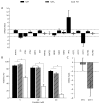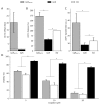Organic cation transporter 3 mediates cisplatin and copper cross-resistance in hepatoma cells
- PMID: 29416650
- PMCID: PMC5787505
- DOI: 10.18632/oncotarget.23142
Organic cation transporter 3 mediates cisplatin and copper cross-resistance in hepatoma cells
Abstract
Platinum-based drugs are first-line compounds in the treatment of many solid cancers. Major obstacles are tumors that become resistant and toxic side effects, both largely due to the expression of transporters that mediate the cellular processing of platinum. In this study, we addressed the establishment of cisplatin resistance in the absence of copper transporter ATP7B that has been previously found to be overexpressed in various resistant cells. Cisplatin sensitivity, induction of apoptosis, drug accumulation, and transporter gene expression were determined in hepatoma cell lines. Knockout or overexpression of copper transporter ATP7B did not affect cisplatin sensitivity. Cisplatin resistant cells showed a stably reduced cisplatin accumulation and a downregulation of organic cation transporter 3 (OCT3). In contrast, OCT3 overexpression could reverse resistance. Reduced MT1 expression was detected in the resistant cell line, however transient and highly dependent on the presence of cisplatin. Cross-resistance to copper was also associated with OCT3 downregulation. Our results suggest that a decreased level of OCT3 expression results in resistance to cisplatin and copper. OCT3 may represent a novel target for improved prognosis and anticancer therapy, including HCC.
Keywords: ATP7B; MT1; OCT3; cisplatin; copper cross-resistance.
Conflict of interest statement
CONFLICTS OF INTEREST The authors declare no potential conflicts of interest.
Figures





Similar articles
-
Modulation of the cellular pharmacology of JM118, the major metabolite of satraplatin, by copper influx and efflux transporters.Cancer Chemother Pharmacol. 2006 Jun;57(6):781-8. doi: 10.1007/s00280-005-0121-5. Epub 2005 Sep 17. Cancer Chemother Pharmacol. 2006. PMID: 16170571
-
Contribution of organic cation transporter 3 to cisplatin cytotoxicity in human cervical cancer cells.J Pharm Sci. 2012 Jan;101(1):394-404. doi: 10.1002/jps.22752. Epub 2011 Sep 8. J Pharm Sci. 2012. PMID: 21905038
-
Cross-resistance of platinum derivatives in H-1R, a cisplatin-resistant cell line.Oncol Rep. 2009 Feb;21(2):443-9. Oncol Rep. 2009. PMID: 19148521
-
Role of copper transporters in platinum resistance.World J Clin Oncol. 2016 Feb 10;7(1):106-13. doi: 10.5306/wjco.v7.i1.106. World J Clin Oncol. 2016. PMID: 26862494 Free PMC article. Review.
-
Membrane transporters as mediators of Cisplatin effects and side effects.Scientifica (Cairo). 2012;2012:473829. doi: 10.6064/2012/473829. Epub 2012 Nov 25. Scientifica (Cairo). 2012. PMID: 24278698 Free PMC article. Review.
Cited by
-
Pharmacogenetics of hepatocellular carcinoma and cholangiocarcinoma.Cancer Drug Resist. 2019 Sep 19;2(3):680-709. doi: 10.20517/cdr.2019.006. eCollection 2019. Cancer Drug Resist. 2019. PMID: 35582588 Free PMC article. Review.
-
Interaction of the New Monofunctional Anticancer Agent Phenanthriplatin With Transporters for Organic Cations.Front Chem. 2018 May 25;6:180. doi: 10.3389/fchem.2018.00180. eCollection 2018. Front Chem. 2018. PMID: 29888219 Free PMC article.
-
Mechanisms of Anticancer Drug Resistance in Hepatoblastoma.Cancers (Basel). 2019 Mar 22;11(3):407. doi: 10.3390/cancers11030407. Cancers (Basel). 2019. PMID: 30909445 Free PMC article. Review.
-
Research progress in cuproptosis in liver cancer.Zhong Nan Da Xue Xue Bao Yi Xue Ban. 2023 Sept 28;48(9):1368-1376. doi: 10.11817/j.issn.1672-7347.2023.230083. Zhong Nan Da Xue Xue Bao Yi Xue Ban. 2023. PMID: 38044648 Free PMC article. Chinese, English.
-
Role of ZIP8 in regulation of cisplatin sensitivity through Bcl-2.Toxicol Appl Pharmacol. 2019 Jan 1;362:52-58. doi: 10.1016/j.taap.2018.10.016. Epub 2018 Oct 17. Toxicol Appl Pharmacol. 2019. PMID: 30342059 Free PMC article.
References
-
- Kelland L. The resurgence of platinum-based cancer chemotherapy. Nat Rev Cancer. 2007;7:573–84. - PubMed
-
- Ishikawa T, Kubota T, Abe S, Watanabe Y, Sugano T, Inoue R, Iwanaga A, Seki K, Honma T, Yoshida T. Hepatic arterial infusion chemotherapy with cisplatin before radical local treatment of early hepatocellular carcinoma (JIS score 0/1) improves survival. Ann Oncol. 2014;25:1379–84. - PubMed
-
- Tanaka S, Shimada M, Shirabe K, Maehara S, Harimoto N, Tsujita E, Sugimachi K, Maehara Y. A novel intrahepatic arterial chemotherapy after radical resection for advanced hepatocellular carcinoma. Hepatogastroenterology. 2005;52:862–5. - PubMed
-
- Ciarimboli G. Membrane transporters as mediators of cisplatin side-effects. Anticancer Res. 2014;34:547–50. - PubMed
LinkOut - more resources
Full Text Sources
Other Literature Sources

